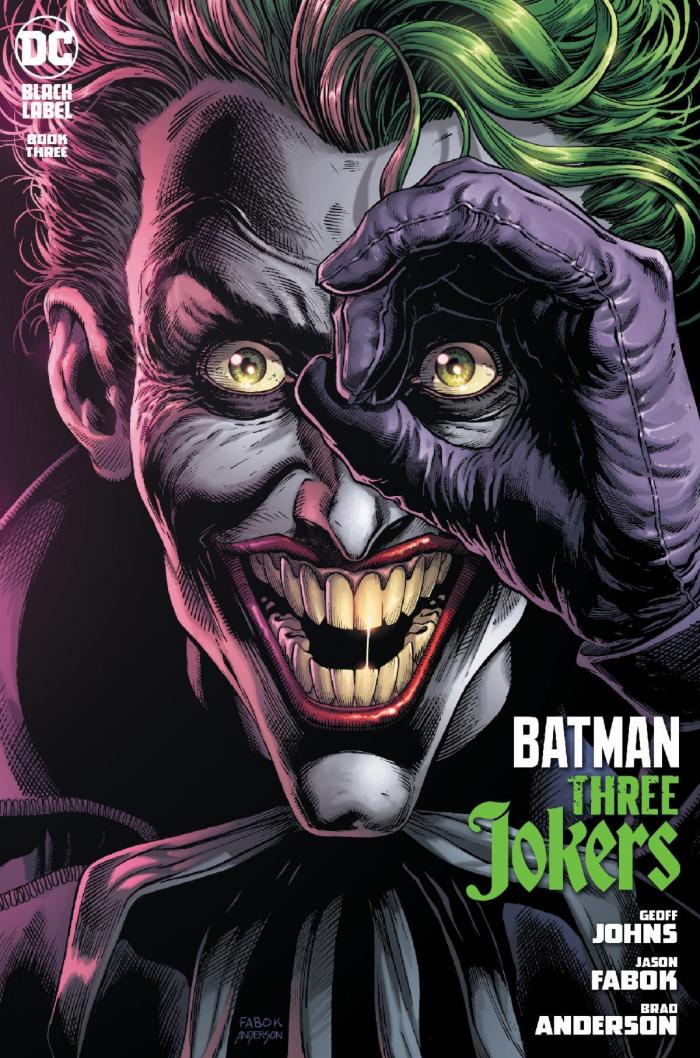Batman: Three Jokers Ends by Undoing Its One Premise
FTC Statement: Reviewers are frequently provided by the publisher/production company with a copy of the material being reviewed.The opinions published are solely those of the respective reviewers and may not reflect the opinions of CriticalBlast.com or its management.
As an Amazon Associate, we earn from qualifying purchases. (This is a legal requirement, as apparently some sites advertise for Amazon for free. Yes, that's sarcasm.)

Warning: This review will contain major spoilers for BATMAN: THREE JOKERS #3.
There's a part of me that wants to review BATMAN: THREE JOKERS based solely on the three issues of the series. That may sound odd to some, but you have to place the story in its original context: that it has been anticipated story for several years now, ever since writer Geoff Johns first dropped the hint when he was writing JUSTICE LEAGUE. But more on that in a little while.
This third issue finds Batman pondering the trail of failed Jokers -- of which there have been at least twenty -- with Batgirl and Red Hood assisting. They continue to dance around the ethics of Jason Todd (aka Red Hood) having shot and killed one of the Jokers in the first issue, knowing that to testify against him would involve unmasking him and themselves. But before they get too deep into that, they get an alert that there's been a breakout at Blackgate Prison -- one with special attachment to Batman. Joe Chill, the man who shot Thomas and Martha Wayne.
But Joe Chill hasn't broken out -- he's been taken by the Jokers, with the plan of making him the next, better Joker, one who would be the ultimate Joker because of his connection to Batman's origin. During the investigation, Batman discovers Joe Chill has been writing un-mailed letters to Bruce Wayne for years, trying to find some way to apologize for his actions, letters he began writing long before his body became filled with cancer.
By the time everything is over, there's one Joker left -- the one, true Joker -- and Batman makes a revelation to Alfred that shocks the faithful butler: he knows who the Joker is, and has always known who the Joker is. This, after he lied directly to Batgirl and Red Hood about whether or not he knew the Joker's identity. He doesn't tell anybody this identity, because, in keeping with the revelations of THE KILLING JOKE, Joker had a family, and Johns rewrites a pivotal scene from the book that has Joker's wife and unborn child survive those events, without derailing the original story. Which, standing alone and, again, looking at just this story, is a brilliant move. Batman knows that if the press found out Joker's name, they'd find and harass his family, destroying innocent people.
 But as I mentioned before, this story has been anticipated for just under a decade. Because in JUSTICE LEAGUE, Batman had obtained access to the Moebius Chair, the sentient computer and travel device of Metron of the New Gods. While in possession of it, he asked the question: What's the Joker's true name? We later learn that the chair's silent response was that there were three Jokers, which Batman found impossible.
But as I mentioned before, this story has been anticipated for just under a decade. Because in JUSTICE LEAGUE, Batman had obtained access to the Moebius Chair, the sentient computer and travel device of Metron of the New Gods. While in possession of it, he asked the question: What's the Joker's true name? We later learn that the chair's silent response was that there were three Jokers, which Batman found impossible.
But this also begs the question: Why did Batman ask if he already knew the answer? Was he testing the chair's capabilities? Or is BATMAN: THREE JOKERS as some have speculated -- not canon, set in an "Elseworlds" bubble? If so, it would certainly explain why the plot device of "zombie Jokers" in a movie theatre showing a film for Batman's benefit -- something we just saw only a month ago in the culmination of "Joker War."
it's beautifully drawn by Jason Fabok, and uniquely and cleverly crafted by Geoff Johns. But I feel like it could have meant more than it does, which is more in the hands of DC Comics editorial than on the creators.


